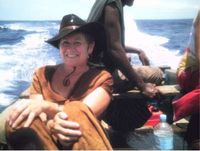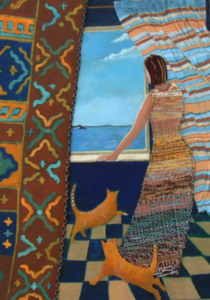Doctor Gretchen Roedde on Her Journey to Expand Healthcare in Remote Ontario Communities
Remote communities in Canada often suffer from a lack medical resources, making illness and injury even more complicated and difficult than it would otherwise be. It's an issue that became a driving force in physician Gretchen Roedde's life. Witnessing the strength of northern communities as they rallied around those in need, she found ways to combine her expertise with those community efforts, in order to better healthcare outcomes for people in northern and remote areas of Ontario.
She chronicles her journey in Deep Water Dream: A Medical Voyage of Discovery in Rural Northern Ontario (Dundurn Press), taking readers with her to a remote Cree community (where she worked with residents to develop a medical dictionary in their own language), Amish home births, and to her life at home on Lake Temiskaming.
She tells us about the significance of the title Deep Water Dream as part of our Entitled interview series, discusses how and where she finds titles for her projects, and shares the painting (which she co-created) that inspired the writing of the book.
Open Book:
Tell us about the title of your newest book and how you came to it.
Gretchen Roedde:
Deep Water Dream is the title of my recent book, published by Dundurn. Temagami and Temiskaming both mean ‘deep water’ in Anishinaabe, the language of the people I lived with on Lake Temagami, but also the lake I live on now, Lake Temiskaming. I was writing a memoir on my life and work in northern Ontario, and this title captured my reflections and stories in both Indigenous, and other northern underserved communities. Much of this book has been written as I looked out over Lake Temagami or Lake Temiskaming.I feel grounded by those lakes and these stories.
OB:
Where is the most unexpected place you've ever found inspiration for a title?
GR:
I was cross-country skiing down Portage Bay Road at our Nordic local ski club. There are erratic boulders on the side of the trail. These boulders are different from the rocks that surround them. Many have been carried hundreds of kilometres by glaciers. I would like the title Erratic. I would remember that one huge rounded craggy rock on the right side of the ski trail, the softly falling flakes of snow, the deep quiet, the careful sloosh sloosh of my skis in their tracks.
OB:
What, in your opinion, is most important function of a title?
GR:
To be a bit mysterious – to draw people in, so you are wondering, ‘What will this be about?’ To ask (not answer) the question, ‘Do I need to read this book?’
OB:
What is your favourite title that you've ever come up with and why? (For any kind of piece, short or long.)
Your CanLit News
Subscribe to Open Book’s newsletter to get local book events, literary content, writing tips, and more in your inbox
GR:
I am pretty happy with Deep Water Dream.
OB:
What is your favourite title as a reader, from someone else's work?
GR:
North Spirit, by Paulette Jiles. This is a stunning book and captures so well the worldview of a non-Indigenous writer, reflecting on the life of the Aboriginal community around her.
OB:
How do you feel about single-word titles?
GR:
I am actually considering a one-word title for my next book – maybe Erratic.
OB:
Did you consider any other titles for your current book and if so what were they? Why did you decide to go with the title you eventually picked?
GR:
My previously published book, A Doctor’s Quest, had the earlier working title A Strange Calling. The title changed in the editing process, after focus group discussions, and I was happy with the change.
OB:
What usually comes first for you: a title or a finished piece of writing?
GR:
This current book started as a painting (see below). I collaborated on a painting for my first book’s cover with my colleague Linda Mustard. We then created a second painting, and I thought, “I guess I have to write a second book, because I have a new cover!” The publisher suggested a different cover, but the book had already been written because I was inspired by that painting – only now it lives as inspiration in my private life. The painting showed a woman looking out over Lake Temiskaming, her two ginger cats at her feet. I decided to write a reflective, introspective piece on my work in northern Ontario, these Deep Water Dreams.
OB:
What quality in a title will consistently make you pick up an unfamiliar book?
GR:
Either a familiar title in a series I have already become addicted to (The Bosch mysteries, for example), or something that is evocative with a strong sense of place.
OB:
What are you working on now?
GR:
I am working on a murder mystery. Fiction based on fact. Its title, and the pseudonym I may write under, are private at the moment. While I have had permission to write personal stories in two books, one about Africa, Asia and the South Pacific, and the other set in northern Ontario, this book will be quite different.
___________________________
Gretchen Roedde, assistant professor at the Northern Ontario School of Medicine, has been a physician since 1978. Working with Indigenous and marginalized communities, she practises near Lake Temiskaming. She has also worked as a public health doctor in the developing world, specializing in mother-and-child health and HIV/AIDS. Gretchen lives in Haileybury, Ontario






